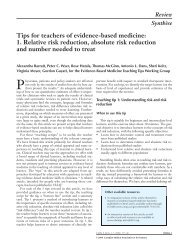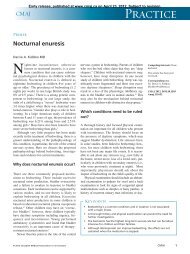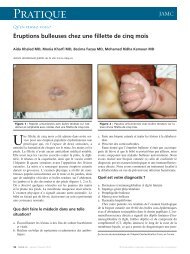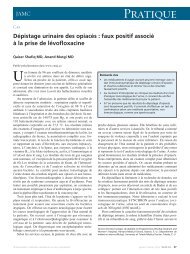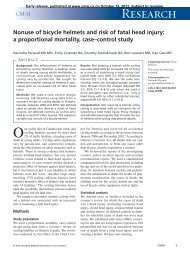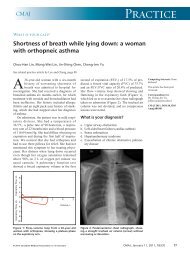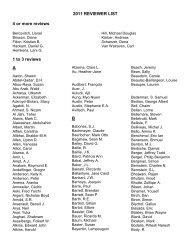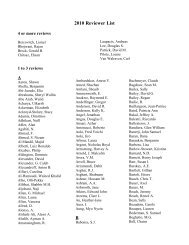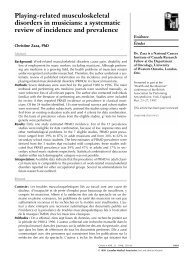The glorification of gout in 16th- to 18th-century literature - Canadian ...
The glorification of gout in 16th- to 18th-century literature - Canadian ...
The glorification of gout in 16th- to 18th-century literature - Canadian ...
You also want an ePaper? Increase the reach of your titles
YUMPU automatically turns print PDFs into web optimized ePapers that Google loves.
<strong>The</strong> Left Atrium<br />
me with her; we both hope it stays that<br />
way for a long, long time. <strong>The</strong>re are<br />
many challenges however, and also opportunities<br />
<strong>in</strong> this<br />
newest phase <strong>of</strong> our<br />
marriage and personal<br />
lives. A gifted,<br />
<strong>to</strong>ugh-m<strong>in</strong>ded, but<br />
warm psychologist<br />
oversee<strong>in</strong>g 4 mental<br />
health cl<strong>in</strong>ics <strong>in</strong><br />
British Columbia,<br />
she has been forced<br />
<strong>to</strong> shut down her<br />
own cl<strong>in</strong>ical practice.<br />
A large part <strong>of</strong><br />
her identity centred<br />
around her work,<br />
with the many<br />
clients that she has<br />
helped over the years and the associated<br />
rewards <strong>of</strong> appreciation from those she<br />
has helped, and <strong>of</strong> know<strong>in</strong>g that she has<br />
provided quality psychotherapy and that<br />
at the end <strong>of</strong> the day she has <strong>in</strong>deed<br />
made a difference.<br />
Fred Sebastian<br />
As for me, I have learned that I can<br />
make 2 types <strong>of</strong> mistakes <strong>in</strong> our daily<br />
<strong>to</strong>-and-fro and give-and-take. <strong>The</strong> first<br />
k<strong>in</strong>d is the anxious<br />
husband reach<strong>in</strong>g out<br />
<strong>to</strong> help his wife when<br />
she neither needs nor<br />
wants assistance. <strong>The</strong><br />
second type <strong>of</strong> error<br />
sees me miss<strong>in</strong>g an<br />
opportunity <strong>to</strong> help<br />
her when she genu<strong>in</strong>ely<br />
needs it. Type<br />
1 errors are more<br />
common and really<br />
tee her <strong>of</strong>f. Type 2 errors<br />
are mercifully<br />
less frequent, or so<br />
she says.<br />
I comfort her when<br />
she’s hav<strong>in</strong>g a bad day, feel<strong>in</strong>g irritated<br />
or frustrated. And sometimes I feel<br />
cheered up myself, reassured and relieved<br />
<strong>in</strong> be<strong>in</strong>g able <strong>to</strong> be there for her.<br />
Most days we enjoy each other and,<br />
sometimes, hugely. Laugh<strong>in</strong>g. Fight-<br />
<strong>in</strong>g. Mak<strong>in</strong>g up. Mak<strong>in</strong>g love. Teas<strong>in</strong>g<br />
and jok<strong>in</strong>g. Snuggl<strong>in</strong>g. Tast<strong>in</strong>g her superb<br />
rhubarb crisp. So just as <strong>in</strong> the<br />
time before Alzheimer disease came<br />
<strong>in</strong><strong>to</strong> our lives, on our very best days we<br />
live contentedly <strong>in</strong> the moment, <strong>in</strong> the<br />
here-and-now.<br />
After all, isn’t that what any <strong>of</strong> us<br />
would do on a good day when we’re<br />
with those who count — our family<br />
and friends? Alzheimer disease is just<br />
an unk<strong>in</strong>d, un<strong>in</strong>vited stranger <strong>in</strong> our<br />
midst. But we don’t have <strong>to</strong> wait until it<br />
comes rudely visit<strong>in</strong>g before we enjoy<br />
our wife or husband or partner, other<br />
family or friends, before we appreciate<br />
— and acknowledge — how much they<br />
mean <strong>to</strong> us.<br />
My grandmother said it better than<br />
ever I could have. “Make hay while the<br />
sun sh<strong>in</strong>es!” she would rem<strong>in</strong>d me <strong>to</strong>day.<br />
David Kirkpatrick MA MD<br />
Psychiatrist and psychotherapist<br />
West Vancouver, BC<br />
Past progressive<br />
<strong>The</strong> <strong>glorification</strong> <strong>of</strong> <strong>gout</strong> <strong>in</strong> <strong>16th</strong>- <strong>to</strong> <strong>18th</strong>-<strong>century</strong> <strong>literature</strong><br />
DOI:10.1503/cmaj.080312<br />
Literary references <strong>to</strong> <strong>gout</strong> are a<br />
prime example <strong>of</strong> the <strong>in</strong>sight<br />
<strong>in</strong><strong>to</strong> popular perceptions <strong>of</strong> disease<br />
that his<strong>to</strong>rical writ<strong>in</strong>gs <strong>of</strong>fer.<br />
While praise <strong>of</strong> podagra is currently <strong>in</strong><br />
short supply, the merits <strong>of</strong> <strong>gout</strong> have<br />
been ex<strong>to</strong>lled over the centuries by<br />
physicians and laypersons. In the past,<br />
<strong>gout</strong> was regarded as a badge <strong>of</strong> nobility,<br />
a talisman aga<strong>in</strong>st other afflictions<br />
and an aphrodisiac, and these beliefs<br />
were preserved <strong>in</strong> <strong>16th</strong>- <strong>to</strong> <strong>18th</strong>-<strong>century</strong><br />
<strong>literature</strong>.<br />
A mark <strong>of</strong> nobility<br />
Gout as a disease <strong>of</strong> the nobility was<br />
referred <strong>to</strong> and expla<strong>in</strong>ed <strong>in</strong> a popular<br />
fable <strong>in</strong>volv<strong>in</strong>g Mr. Gout and the spider.<br />
This s<strong>to</strong>ry has been traced <strong>to</strong> the<br />
n<strong>in</strong>th <strong>century</strong>, 1 and the first English<br />
version <strong>of</strong> it was recorded <strong>in</strong> a medical<br />
handbook by the Puritan Richard<br />
Hawes <strong>in</strong> 1634. 2<br />
<strong>The</strong> tale tells <strong>of</strong> Monsieur Gout and<br />
his travell<strong>in</strong>g companion, the spider.<br />
Mr. Gout lodged with a poor man, and<br />
the spider with a rich man. When they<br />
reviewed their accommodations the<br />
next day, both had compla<strong>in</strong>ts.<br />
“‘M<strong>in</strong>e,’ said the Gout, ‘was the<br />
worst as ever I had, for I had no sooner<br />
<strong>to</strong>uched the poor man’s legs, th<strong>in</strong>k<strong>in</strong>g<br />
there <strong>to</strong> take my rest, but up he gets,<br />
and <strong>to</strong> thrash<strong>in</strong>g he goes, so that I had<br />
no rest the whole night.’<br />
‘And I,’ said the spider, ‘had no<br />
sooner begun <strong>to</strong> build my house <strong>in</strong> the<br />
rich man’s chamber, but the maid<br />
came with a broom, and <strong>to</strong>re down all<br />
my work.” 3<br />
<strong>The</strong>y then agreed <strong>to</strong> change places<br />
and were so pleased with their respective<br />
new homes that they each decided<br />
<strong>to</strong> put up permanent residence, for the<br />
spider’s webs were not disturbed by the<br />
poor man, and “the Gout he was enter-<br />
ta<strong>in</strong>ed with a s<strong>of</strong>t cushion, with down<br />
pillows, with da<strong>in</strong>ty caudles, and delicate<br />
broths. In brief, he did like it so<br />
well, that ever s<strong>in</strong>ce he takes up his<br />
lodg<strong>in</strong>g with rich men.” 3<br />
This fable purports <strong>to</strong> expla<strong>in</strong><br />
<strong>gout</strong>’s apparent predilection for the<br />
upper class. Gout was referred <strong>to</strong> as<br />
morbus dom<strong>in</strong>orum et dom<strong>in</strong>us morborum,<br />
lord <strong>of</strong> disease and disease <strong>of</strong><br />
lords, 4,5 because <strong>of</strong> its respectable antiquity<br />
and its association with <strong>in</strong>temperance<br />
afforded only by the wealthy.<br />
Gout was personified as one <strong>of</strong> the<br />
Greek deities, Podagra, born <strong>of</strong> Dionysus<br />
(Bacchus), the god <strong>of</strong> w<strong>in</strong>e, and<br />
Aphrodite (Venus), the goddess <strong>of</strong><br />
love. 5–7 <strong>The</strong> idea that <strong>gout</strong> resulted<br />
from service <strong>to</strong> these gods and was a<br />
consequence <strong>of</strong> over<strong>in</strong>dulgence <strong>in</strong> sex,<br />
food and w<strong>in</strong>e was recorded by ancient<br />
Roman authors and persisted <strong>in</strong><strong>to</strong><br />
the Christian era. 6–8<br />
804<br />
CMAJ • OCTOBER 7, 2008 • 179(8)<br />
© 2008 <strong>Canadian</strong> Medical Association or its licensors
<strong>The</strong> Left Atrium<br />
A good-luck piece<br />
Another popular idea <strong>of</strong> <strong>16th</strong>- <strong>to</strong> <strong>18th</strong><strong>century</strong><br />
Europe was that <strong>gout</strong> was a<br />
remedy rather than a disease. Jonathan<br />
Swift (1667–1745), the Irish author and<br />
satirist, articulates this concept <strong>in</strong> his<br />
poem for his acqua<strong>in</strong>tance Rebecca<br />
D<strong>in</strong>gley entitled “Bec’s Birthday”<br />
(1726).<br />
As, if the <strong>gout</strong> should seize the head,<br />
Doc<strong>to</strong>rs pronounce the patient dead;<br />
But, if they can, by all their arts,<br />
Eject it <strong>to</strong> th’extreamest parts,<br />
<strong>The</strong>y give the sick man joy, and praise<br />
<strong>The</strong> <strong>gout</strong> that will prolong his days:<br />
Rebecca thus I gladly greet,<br />
Who drives her cares <strong>to</strong> hands and feet. 9<br />
Gout was unders<strong>to</strong>od <strong>to</strong> be <strong>in</strong>compatible<br />
with most other afflictions, <strong>in</strong><br />
keep<strong>in</strong>g with the age-old idea that diseases<br />
were mutually exclusive. As<br />
such, <strong>gout</strong> was regarded as a cure, a<br />
vacc<strong>in</strong>e, an <strong>in</strong>surance policy aga<strong>in</strong>st<br />
worse illness. 5 In his letters, the English<br />
writer Horace Walpole claimed, “It<br />
prevents other illness and prolongs life.<br />
Could I cure the <strong>gout</strong>, should not I have<br />
a fever, a palsy or an apoplexy?” 5 He<br />
went on, “I believe the <strong>gout</strong> a remedy<br />
and not a disease, and be<strong>in</strong>g so no wonder<br />
there is no medic<strong>in</strong>e for it, nor do I<br />
desire <strong>to</strong> be fully cured <strong>of</strong> a remedy.” 10<br />
Gout was sought by some who did<br />
not have it. In the <strong>18th</strong> <strong>century</strong>, patients<br />
suffer<strong>in</strong>g from consumption or melancholy<br />
were sent by their physicians <strong>to</strong><br />
the waters at Bath <strong>in</strong> the hope <strong>of</strong> acquir<strong>in</strong>g<br />
<strong>gout</strong> and so oust<strong>in</strong>g their other<br />
sickness. 5,10<br />
Podagra as an aphrodisiac<br />
Gout was also <strong>to</strong>uted as hav<strong>in</strong>g aphrodisiac<br />
properties. <strong>The</strong> earliest reference<br />
<strong>to</strong> <strong>gout</strong> as an aphrodisiac is the Podagra<br />
Encomium <strong>of</strong> 1562 by Hieronymus<br />
Cardanus <strong>of</strong> Pavia (1501–1576). 11<br />
A<br />
physician and mathematician, Cardanus<br />
expla<strong>in</strong>ed <strong>in</strong> his encomium, a<br />
formal yet facetious expression <strong>of</strong><br />
praise, that: “For with Venus and Bacchus<br />
and the feasts <strong>of</strong> voluptuaries an<br />
abid<strong>in</strong>g covenant serves as check, and<br />
such a cause <strong>of</strong> happ<strong>in</strong>ess is she [the<br />
<strong>gout</strong>] that those who are restra<strong>in</strong>ed by<br />
her are compelled <strong>to</strong> lead lives that, except<br />
for the pa<strong>in</strong> itself are happy. For<br />
National Library <strong>of</strong> Medic<strong>in</strong>e<br />
she does not render them sterile but res<strong>to</strong>res<br />
them <strong>to</strong> Venus with <strong>in</strong>creased<br />
prowess.” 11<br />
T.G. Benedek reviews several reasons<br />
that were postulated for this sexual<br />
performance–enhanc<strong>in</strong>g character<br />
<strong>of</strong> <strong>gout</strong>. 11 In his 1588 essay, “Of Cripples,”<br />
Michel de Montaigne, the<br />
French Renaissance writer, expla<strong>in</strong>s<br />
that when the legs are crippled (by any<br />
cause) and “do not receive the food<br />
that is their due … the genital parts …<br />
are fuller, better nourished, and more<br />
vigorous. or else that, s<strong>in</strong>ce this defect<br />
prevents exercise, those who are<br />
ta<strong>in</strong>ted by it dissipate their strength<br />
less and come more entire <strong>to</strong> the sports<br />
<strong>of</strong> Venus.” 11<br />
In 1693, Gerhardus Feltmann, a<br />
17th-<strong>century</strong> Dutch jurist, suggested<br />
that the sexual prowess <strong>of</strong> a person suffer<strong>in</strong>g<br />
with <strong>gout</strong> was due <strong>to</strong> the <strong>in</strong>cubat<strong>in</strong>g<br />
effect <strong>of</strong> bed rest on the reproductive<br />
organs: “For when a patient who is<br />
suffer<strong>in</strong>g from <strong>gout</strong> is forced <strong>to</strong> lie on<br />
his back, anyone who knows that the<br />
channels <strong>of</strong> the sperm trace their source<br />
<strong>to</strong> the kidneys can easily and at his<br />
leisure comprehend that the lo<strong>in</strong>s and<br />
kidneys are hot and <strong>in</strong>flamed.” 11<br />
His<strong>to</strong>rical conceptions <strong>of</strong> <strong>gout</strong> may<br />
be enterta<strong>in</strong><strong>in</strong>g and the current metabolic<br />
def<strong>in</strong>ition <strong>of</strong> the disease considered<br />
a scientific advancement, however,<br />
if I were <strong>to</strong> diagnose <strong>gout</strong> <strong>in</strong> a<br />
patient <strong>to</strong>day, I would prefer <strong>to</strong> temper<br />
the announcement with the reassurance<br />
that the condition guaranteed <strong>in</strong>creased<br />
social status, a reduction <strong>of</strong> cancer risk,<br />
and an end <strong>to</strong> Viagra refills.<br />
Mart<strong>in</strong>a Scholtens MD<br />
John Ruedy Immunodeficiency Cl<strong>in</strong>ic<br />
St. Paul’s Hospital<br />
Bridge Community Health Cl<strong>in</strong>ic<br />
Vancouver Coastal Health<br />
Vancouver, BC<br />
REFERENCES<br />
1. Rodnan GP, Benedek TG. Gout and the spider.<br />
JAMA 1970;211:2157.<br />
2. Benedek TG. Popular <strong>literature</strong> on <strong>gout</strong> <strong>in</strong> the <strong>16th</strong><br />
and 17th centuries. J Rheuma<strong>to</strong>l 1987;14:186.<br />
3. Eamon W. <strong>The</strong> tale <strong>of</strong> monsieur <strong>gout</strong>. Bull Hist<br />
Med 1981;55:564-7.<br />
4. Hart FD. Gout and non-<strong>gout</strong> through the ages. Br J<br />
Cl<strong>in</strong> Pract 1985;39:91-2.<br />
5. Porter R. Gout: fram<strong>in</strong>g and fantasiz<strong>in</strong>g disease.<br />
Bull Hist Med 1994;68:1-28.<br />
6. Rodnan GP. Early theories concern<strong>in</strong>g etiology<br />
and pathogenesis <strong>of</strong> the <strong>gout</strong>. Arthritis Rheum<br />
1965;8:599-610.<br />
7. Benedek TG. <strong>The</strong> <strong>gout</strong> <strong>of</strong> Desiderius Erasmus and<br />
Willibald Pirckheimer: medical au<strong>to</strong>biography and<br />
its literary reflections. Bull Hist Med 1983;57:526-<br />
44.<br />
8. Benedek TG, Rodnan GP. Podagra by Gottfried<br />
Rogg: an illustrated encomium on the <strong>gout</strong>. J Hist<br />
Medic<strong>in</strong>e Allied Sci 1963;18:349-52.<br />
9. Swift J. Bec’s Birthday. In: Williams H, edi<strong>to</strong>r.<br />
<strong>The</strong> poems <strong>of</strong> Jonathan Swift. 2nd ed. Oxford<br />
(UK): Clarendon Press; 1937. p.761.<br />
10. Copeman WSC. A short his<strong>to</strong>ry <strong>of</strong> the <strong>gout</strong> and the<br />
rheumatic diseases. Berkeley and Los Angeles:<br />
University <strong>of</strong> California Press; 1964.<br />
11. Benedek TG. Disease as aphrodisiac. Bull Hist<br />
Med 1971;4:322-40.<br />
CMAJ • OCTOBER 7, 2008 • 179(8)<br />
© 2008 <strong>Canadian</strong> Medical Association or its licensors<br />
805





